#tokugawa hidetada
Photo

戦国無双~真田丸~ - 徳川秀忠
6月22日分の30分くらいらくがき。
どの形態の秀忠さんもすき。(青年期抜け)
3 notes
·
View notes
Text
栃木県
Japanese Prefectures: Kantō - Tochigi
都道府県 (とどうふけん) - Prefectures of Japan
Learning the kanji and a little bit about each of Japan’s 47 prefectures!
Kanji・漢字
栃 とち horse chestnut
木 き、こ~、ボク、モク tree, wood
県 ケン prefecture
関東 かんとう Kanto, region consisting of Tokyo and surrounding prefectures
Prefectural Capital (県庁所在地) : Utsunomiya (宇都宮市)

One of only eight land-locked prefectures in Japan, Tochigi prefecture is famous for gyoza and strawberries. It is also home to Japan's oldest school of higher education, the Ashikaga Gakkō, and is home to the Tōshō-gū shrine, dedicated to the shogun who unified Japan, Tokugawa Ieyasu, in the city of Nikkō.
Tochigi lies just north of Tokyo, and is accessible in less than an hour by bullet train. Nasu is the location of one of the imperial family's villas, and hot springs near Nasu and Shiobara mountains are popular resort spots. In the southeast of Tochigi, the town of Mashiko is renowned for its simple but highly prized ceramics.
Recommended Tourist Spot・おすすめ観光スポット
World Heritage Site Nikkō Tōshōgū - 世界遺産・日光東照宮

Nikkō is closely associated with Tokugawa Ieyasu, who unified the country after a century of warfare and founded the Tokugawa shogunate. Ieyasu retired and then passed away in present-day Shizuoka Prefecture, and was laid to rest at Kunōzan. In 1617, his remains were moved to Nikkō and he was deified as the protector of the eight Kantō provinces.
Ieyasu’s remains were reinterred at the temple Rinnōji in Nikkō, and his successor Hidetada erected the Tōshōsha in his honor. The third Tokugawa shogun Iemitsu had great respect for Ieyasu and ordered the original shrine renovated, having the country’s most skilled artisans create the richly decorated buildings that stand today. The work was completed in 1636, and nine years later the imperial court bestowed the name Tōshōgū on the shrine.
Nikkō Tōshōgū boasts eight buildings designated as national treasures and thirty-four structures selected as important cultural properties. Some of these impressive cultural properties include the 9.2-meter-tall stone torii marking the entrance and the five-storied pagoda nearby, as well as the Yōmeimon, a richly decorated gate with over 500 carvings depicting fables and saints. This magnificent gate holds an ancient superstition, which said that completing it might lead to the collapse of the Tokugawa regime. To avoid this, the builders installed one of the twelve supporting pillars upside down, thus insuring that it remained incomplete.
For more photos and information check out: nippon.com
Regional Cuisine - 郷土料理
Gyoza Dumpling - 餃子
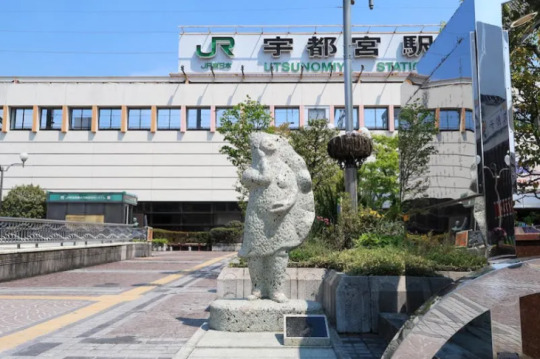
A statue of the goddess Venus wrapped in gyoza skin outside Utsunomiya Station (source)
“Utsunomiya Gyoza” is an important part of the culinary culture of Utsunomiya City. The city has over 300 gyoza restaurants, and queuing in front of your favorite restaurant or visiting multiple restaurants is quite common. The restaurants compete to create unique recipes in order to be recognized as the best gyoza in the city. You can even join gyoza-making classes led by top chefs. There is also a gyoza association called the Utsunomiya Gyozakai that holds an annual festival in the beginning of November.
Tochigi Dialect・Tochigi-ben・栃木弁
こわい kowai tired
「とうと登ってたっけ、こわいから座ってもいいけ?」
touto nobottetakke, kowai kara suwatte mo iike?
Standard Japanese: 「ずっと登ってたし、疲れたから座ってもいい?」
(zutto nobottetashi, tsukareta kara suwatte mo ii?)
English: "I've been climbing for a while now, and I'm tired, so can I sit down?"
いかんべ ikanbe it's good
A: 「こんなもんで、いがっぺ?」
(konna mon de, igappe?)
B: 「いかんべ。」
(ikanbe)
Standard Japanese:
A: 「こんなもんで、いいでしょう?」
(konna mon de, ii deshou?)
B: 「いいですよ。」
(ii desu yo)
English:
A: "Is it okay if I do it like this?"
B: "Yes, that's fine."
いじやける ijiyakeru irritated
「あの店員の態度、すげ~いじやける!」
(ano tenin no taido, suge~ijiyakeru!)
Standard Japanese: 「あの店員の態度、凄くイライラする!」
(ano tenin no taido, sugoku iraira suru!)
English: "That store clerk's attitude, is so irritating!"
だいじだ daiji no problem
A: 「だいじ?」 (daiji?)
B: 「だいじだいじ!」 (daiji daiji!)
Standard Japanese:
A: 「大丈夫?」 (daijyoubu?)
B: 「大丈夫、大丈夫!」 (daijyoubu, daijyoubu!)
English:
A: "Is it ok?"
B: "No problem, no problem!"
あかなす akanasu tomato (lit. red eggplant)
Standard Japanese: トマト (tomato)
English: tomato
#japanese prefectures#日本語#japanese#japanese language#japanese langblr#langblr#studyblr#都道府県#栃木県#tochigi
42 notes
·
View notes
Video
Repost from @hamamatsu_tokugawa
Tokugawa Hidetada sword
194 notes
·
View notes
Text
JUNE - 1628
PHILIP II, life extended by dark alchemy, is master of Earth, and of Spain's colonies beyond. Only an alliance between CARDINAL RICHELIEU and TOKUGAWA HIDETADA stands between Spain and control of the entire Solar System.
THE AETHERIC VOID IS NOW A BATTLEFIELD
12 notes
·
View notes
Text

Model of the Taitokuin Mausoleum 1909-10
Wood, lacquer, copper alloy, painted and partially gilded
The model is an accurate one-tenth scale facsimile of the Taitokuin Mausoleum, dedicated to the second Tokugawa shogun, Hidetada, who died in 1632. The Mausoleum was constructed shortly after his death at the Tokugawa family temple of Zojo-ji in Edo (now Tokyo). It was made by the leading architects, builders, sculptors and artists of the day and served as the prototype for the rebuilding of the Nikko Toshogu in 1634-36. The Mausoleum was destroyed in the war-time bombing of Tokyo in May 1945.
The model was commissioned by the City of Tokyo for display at the Japan-British Exhibition at White City, London, from May to October 1910, at which millions of Londoners gained their first experience of Japanese culture. It was made while the actual Mausoleum still stood, and was based on precise measurements and study of its architecture and decoration. As it is very large, the model was made with many of the same materials and techniques of the original, including timber frame joinery by temple carpenters, maki-e (gold and silver lacquerwork) metal work and polychromy.
Royal Collection Trust
14 notes
·
View notes
Text

Lady Saigō (1552 – 1 July 1589), also known as Oai, was the first consort and trusted confidante of Tokugawa Ieyasu, the samurai lord who unified Japan at the end of the sixteenth century and then ruled as shōgun. She was also the mother of the second Tokugawa shōgun, Tokugawa Hidetada. Her contributions were considered so significant that she was posthumously inducted to the Senior First Rank of the Imperial Court, the highest honor that could be conferred by the Emperor of Japan.
During their relationship, Lady Saigō influenced Ieyasu's philosophies, choice of allies, and policies as he rose to power during the late Sengoku period, and she thus had an indirect effect on the organization and composition of the Tokugawa shogunate. Although less is known of her than some other figures of the era, she is generally regarded as the "power behind the throne", and her life has been compared to a "Cinderella story" of feudal Japan.
Once she was in a respected and secure position as first consort and mother to Ieyasu's heir, Lady Saigō used her influence and wealth for charitable purposes. A devout Buddhist, she donated money to temples in Suruga Province, where she resided as the consort of Ieyasu, first in Hamamatsu Castle and later in Sunpu Castle. As she was quite near-sighted, she also established a charitable organization that assisted visually impaired women with no other means of support. Lady Saigō died at a fairly young age, under somewhat mysterious circumstances. Although murder was suspected, no culprit was identified.
Lady Saigō bore four children: she had a son and a daughter (Saigō Katsutada and Tokuhime) while married, and she later bore two sons as the consort of Tokugawa Ieyasu: Tokugawa Hidetada and Matsudaira Tadayoshi. Among the descendants of Lady Saigō was the Empress Meishō (1624–1696), one of very few women to accede to the Chrysanthemum Throne as empress regnant.
31 notes
·
View notes
Note
do you have any information about joshin? ive been trying to find stuff about nobukatsu's later years but only know surface level stuff (bulit a big garden, had a silkworm farm and sold them, and lived a carefree life as an old man etc) though i want to know if theres a little more or if im missing something.
There is nothing much to it. He already retired after the Osaka battles, and even the silkworm farm seemed to have nothing to do with him either. His domains in Obata and Matsuyama were apparently run by his sons and/or vassals, and he himself just lived a retirement life in Kyoto. The garden was built, but he himself didn't even go to see it.
The only interesting thing that happened that I was able to find was that in 1628 Hidetada or Iemitsu invited him for a tea ceremony. By all accounts it appears he just didn't really do anything but just have a relaxed retirement once the Edo government is settled.
The cited materials are books and government documents that isn't free to view on the libraries I usually use, unfortunately. I actually have to have some sort of verified registration to look at it, so if there's actually more info in there, I can't see.
Now, if you're asking for Joushin in the time before Hideyoshi's death, Sekigahara, or the Osaka battles, there has been a lot of conspiratorial speculations there.
I will need to pull up the reference later, but I remembered reading in passing a story from one of the Tokugawa chronicles where Ieyasu told his vassals to make sure to get Nobukatsu out of Osaka safely. Tokugawa chronicles are propaganda so aren't entirely reliable, but if this one happens to be truthful, then it supports the version of narrative where he was present in Osaka during the Summer or Winter campaign.
2 notes
·
View notes
Text
Nampō Roku, Book 7 (80): Concerning Lord Hino’s¹ Use of Kayari [蚊遣]² in the Roji.

80) Concerning [his connection with] Rikyū-koji, Hino Terusuke had become his disciple, and [they] frequently visited [each other]³.
On an evening in the summer, [Terusuke] set up a kayari-bi [蚊遣火] in his garden, in the shade under the trees⁴. When [Ri]kyū saw this [he said] “indeed, isn’t that most tasteful!” -- he was deeply moved⁵.
Since then [it has become the practice that], in a secluded place in the roji [and] near the koshi-kake, in a suitable place in the shade under the trees, the kayari should be set to smoldering [in order to keep the area free of mosquitoes]⁶.
_________________________
◎ The toku-shu shahon version of this entry agrees with the Enkaku-ji manuscript. However, according to both Tanaka Senshō and Shibayama Fugen -- and rather curiously -- the genpon text substitutes the name of Lord Asukai [飛鳥井殿] (perhaps Asukai Masakata [飛鳥井雅賢; 1585 ~ 1626], who held the lower grade of the junior fourth rank, and was Sakon-e no shosho [左近衛少将], equivalent to lieutenant-general of the Sakon [Left] Guards unit) for that of Hino Terusuke [日野輝資; 1555 ~ 1623]. This is strange because, while Lord Hino is known to have been a disciple of Rikyū (he is mentioned several times in the Nampō Roku in this capacity), a connection between Rikyū and Lord Asukai is less well documented*.
___________
*In 1609, Asakai Masakata was exiled to Naka-no-shima [中之島] in Oki [隠岐] (a group of islands northwest of the border between Tottori and Shimane Prefectures) on account of having seduced one of the emperor’s ladies-in-waiting. Masakata died in exile later in 1626.
Masakata is not recorded to have had any interest in chanoyu, and there does not appear any other reason to associate Masakata with Rikyū.
The Asakai family was established during the Heian period, but they were always more closely associated with waka [和歌] and kemari [蹴鞠] than with other cultural activities. (Kemari, which appeared in something resembling its present form toward the end of the Heian period, is usually described as a kind of football; but the object of the game was to keep the ball in the air, and prevent it from touching the ground: after kicking the ball, that player had to intone an original waka before the ball was kicked again. As can be seen below, the participants usually wore casual court dress, as well as their lacquered caps of estate.)
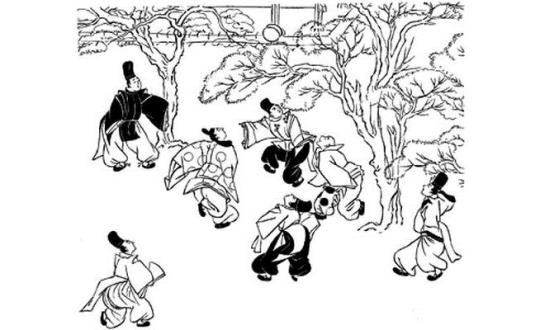
Members of the Asakai family were the instructors of kemari to the Ashikaga shōgun Yoshimasa and Yoshinao, and their courts. During the fifteenth century the Asakai also founded the Niraku school [二楽流] of calligraphy. Their fortunes seem to have declined in tandem with those of the Ashikaga house, so that they were remembered more for the scandal involving Masakata, than for other accomplishments during the sixteenth and seventeenth centuries.
¹Hino Terusuke [日野輝資; 1555 ~ 1623] was a scion of the hereditary court nobility (kuge [公卿]), who served in various governmental posts, ultimately being appointed Gon-dainagon [権大納言] (Supernumerary Grand Counselor of State) in 1597, at which time he was elevated to the senior grade of the Second Rank. He was thus the highest ranking among Rikyū's noble disciples.
Terusuke retired from government service in the Fifth Month of Keichō 12 [慶長十二年] (1607) and became nyūdō, taking the name Yuishin-in [唯心院]. Nevertheless, it seems that he remained a counselor to both Tokugawa Ieyasu and his son Hidetada until his death.
²Kayari [蚊遣] means mosquito repellent, and usually referred to burning pine-needles or dried mugwort (or an incense compounded from the latter) for this purpose. The practice had been employed at the Imperial Court since ancient times, but this occasion appears to have been the first time that it was used in the roji -- to rid the roji and koshi-kake of mosquitos during a chakai.
³Rikyū-koji ha, Hino Terusuke no montei ni natte, tsune ni mairare-keri [利休居士ハ、日野輝資ノ門弟ニ成テ、常ニ參ラレケリ].
Rikyū-koji ha [利休居士は] means concerning Rikyū-koji.
Koji [居士] was the “non-title” (meaning a Buddhist layman, or lay believer -- that is, a follower who had not formally taken the tonsure) that was bestowed on Rikyū in early 1586, so he could enter the Imperial Palace and assist* Hideyoshi’s service of tea to the Emperor Ōgimachi [正親町天皇; 1517 ~ 1593 -- his reign extended from the 27th day of the Tenth Month of Kōji 3 [弘治三年], 1557, to the 7th day of the Eleventh Month of Tenshō 14 [天正十四年], 1586] in Hideyoshi’s golden tearoom (which was set up on the deep veranda of one of the halls within the palace compound).
Hino Terusuke no montei ni natte [日野輝資の門弟になって]: this phrase is grammatically irregular; but the meaning seems to be that Hino Terusuke was one of Rikyū’s disciples†.
Tsune ni mairare-keri [常に參られけり] means that (he) frequently desired to visit‡ -- while this is usually understood to mean that Terusuke often visited Rikyū, the context of this entry implies that the visits between the two were reciprocal.
Here, and throughout the entire passage, he toku-shu shahon agrees exactly with the Enkaku-ji text**.
___________
*Despite occasional assertions to the contrary that are found in the popular tea histories, Rikyū’s job on this occasion was primarily to grind the tea, help prepare the utensils, and take care of various things that had to be done in the preparation area (such as emptying the koboshi, and returning it after cleaning, so Hideyoshi could replace it on the daisu), and sit in the vicinity of the sadō-guchi, ready to offer any advice that Hideyoshi might have needed. The surviving accounts suggest that the daisu-temae that Hideyoshi employed on this occasion used a bon-chaire and dai-temmoku, and everything used was either made of gold, or made of wood covered with gold (the temmoku was made in that way, since a gilded ceramic bowl would have been too heavy, and potentially could have been too hot to hold comfortably).
On this occasion, Rikyū did not meet the Emperor or serve him tea while Hideyoshi sat and chatted with the Emperor (the way some popular versions of the story suggest). Indeed, the Emperor would have been entirely unaware of Rikyū’s presence.
†Linguistically, the construction of this phrase seems to suggest that Rikyū became Lord Hino’s disciple, which is nonsense.
‡The suffix -keri [けり] might be interpreted to suggest that this was something that happened in the past, something that had already ceased to occur by the time that this text was written down.
And, indeed, as Lord Hino rose higher and higher in the government, he would have had correspondingly less time to indulge in things like chanoyu.
**As does the genpon text -- except that, as noted above, the genpon version inserts the name Asukai-dono [飛鳥井殿], Lord Asukai, in place of Hino Terusuke [日野輝資]: Rikyū-koji ha, Asukai-dono no montei ni natte, tsune ni mairare-keri [利休居士ハ、飛鳥井殿ノ門弟ニ成テ、常ニ參ラレケリ].
There does not seem to be any historical justification that might account for this change in the text, however, so it is difficult to imagine how the substitution came to be made by the editors of the genpon edition. Tanaka Senshō, however, argues that the reason for the name change was because of the Asakai family’s traditional connection with kemari (that was mentioned in the sub-note below my introduction). Because the Asakai were the national experts, the men of their family would have had to practice kemari out-of-doors throughout the year. During the summer months, because of the discomfort caused by mosquitoes (not only while playing, but also while resting between innings in the shade of the trees in the garden), they began to burn mosquito repellent in the garden to make their long practice sessions more endurable. Nevertheless, this does not give us any clues as to why Rikyū would have been visiting them, or why he would have been so deeply impressed by the idea of burning kayari in the garden.
⁴Natsu yū-gata, o-niwa no ko-kage ni kayari-bi wo tateraretari wo [夏ノ夕方、御庭ノ木陰ニ蚊遣火ヲタテラレタルヲ].
Natsu yū-gata [夏の夕方] means on an evening during the summer.
O-niwa [御庭]: the honorific o- [御] was probably used because Lord Hino was a member of the kuge [公卿], the hereditary court nobility, so the use of the polite form would indicate unambiguously that this garden was in his residence.
O-niwa no ko-kage ni kayari-bi wo tateraretari wo [御庭の木陰に蚊遣火を立てられたるを] means that in (Lord Hino’s) garden, in the shade of the trees*, a kayari-bi [蚊遣火]† was set up.
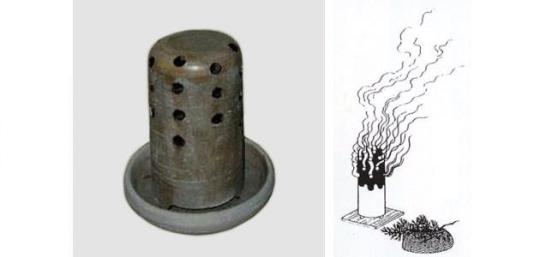
A kayari-bi was an openwork (usually ceramic) brazier (an Edo-period example of a kayari-bi that was made to be set on the floor of a room is shown above) in which either dried pine-needles, or stalks of dried mugwort (Artemisia princeps, and possibly other species)‡, were set to smoldering, since the smoke from these plants had mosquito-repelling properties.
However, by the point in the Edo period when this text was written, mosquito-repellent incense sticks (katori-senkō [蚊取線香]**), made from crushed mugwort mixed with charcoal powder, also seem to have been invented, so this entry could be referring to either form of kayari.
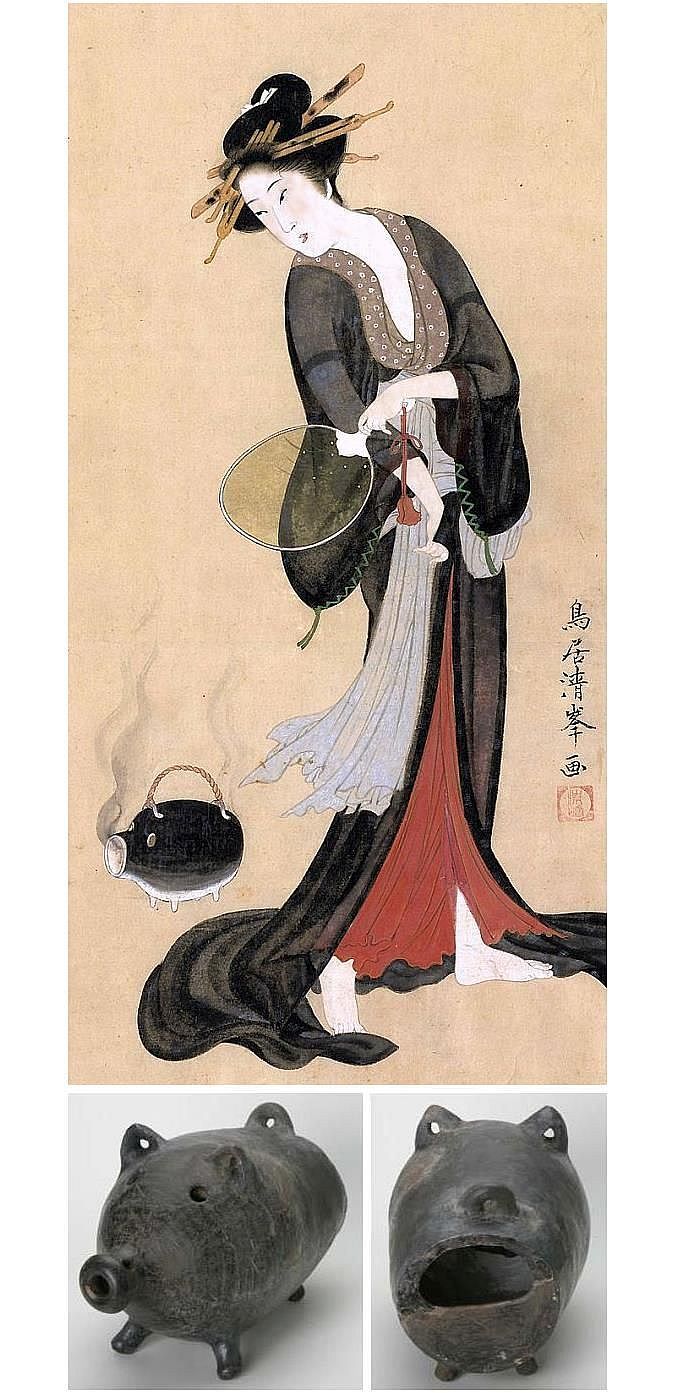
The above painting, titled Kayari-bijin [蚊遣美人] (“a Beauty with a kayari-bi”), by Torii Kiyomine [鳥居清峯; 1836 ~ 1867] shows how a handle was attached to another Edo-period example of a katori-bi (an antique example is shown below the painting -- the pine-needles, stalks of mugwort, or a coil of mosquito incense, would be placed inside through the large hole in the back side of the kayari-bi). The handle was used to carry the kayari-bi from place to place, as needed, to keep the mosquitos away††.
__________
*Since the gathering during which this kayari-bi was set up in the roji was held in the evening, the shade from the trees is probably less important to the story than the fact that the kayari-bi was placed somewhere where it would not be seen. The purpose was, of course, to chase away the mosquitoes and other night insects from the vicinity of the koshi-kake and roji.
†With respect to this use of a kayari-bi in the roji, Tanaka Senshō comments:
Kayari de naku, eji-kago tote, niwa no tsūro ni kō wo taku-koto ha ko-rai aru. Ka no dō no tsuru ya, kamo nado wo tei-jō ni oite kō wo taku-koto ha, ko-rai okonawareta-koto de aru. Kono-koto kara, kayari wo omoi-tsuita no de arau ka. Roji ni kayari wo tateta-koto ha, mukashi to shite omoshiroi shu-mi de aru. Ima-doki ha, ryōri-ya no teien ni, katori-senkō ga takarete-iru ga, kore ha fūryū to ha ienu. Yahari, eji-kago nado suete, mukashi-fū no kayari-bi no kata ga omoshiroi to omou
[蚊遣でなく、衛士籠とて、庭の通路に香を炷く事は古来ある。彼の銅の鶴や、鴨抔を庭上に置いて香を炷く事は、古来行われた事である。此事から、蚊遣を思ひ付いたのであらうか。露地に蚊遣を立てた事は、昔として面白い趣味である。今時は、料理屋の庭園に、蚊取線香が炷かれているが、是は風流とは云ヘぬ。やはり、衛士籠抔据ゑて、昔風の蚊遣り火の方が面白いと思ふ].
“In the absence of a kayari, since ancient times it has been the practice that even [something like] an eji-kago [衛士籠] might be set up beside the garden path and used for burning incense. As for placing bronze cranes and ducks and the like in the garden for burning incense [to perfume the air], this has been done since ancient times. Perhaps this was how they came up with the idea of [burning] kayari? Setting up the kayari in the roji must have been a interesting way to amuse [oneself] in bygone days. Nowadays, katori-senkō is burned in the gardens of restaurants, but [I don’t] think this can be called tasteful. I think it would be much more interesting to set up an eji-kago and make use of this old-fashioned way of repelling mosquitos!”
An eji-kago [衛士籠] (the name means a sentry’s/gatekeeper’s basket -- by the light of which the guard was able to identify people approaching the gate for admittance) was (originally) an iron basket, suspended from or on some sort of stand or tripod (as can be seen below), in which wood was kindled for illumination. This arrangement was also referred to as a kagari-bi [篝火] -- as in the following Edo period illustration for chapter 54 of the Genji monogatari [源氏物語] (which sets the scene on a veranda whose garden is illuminated in this way). In the picture we see a line of kagari-bi (often translated as “flares”) set up along the bank of the garden stream, with the fires attended by underlings.
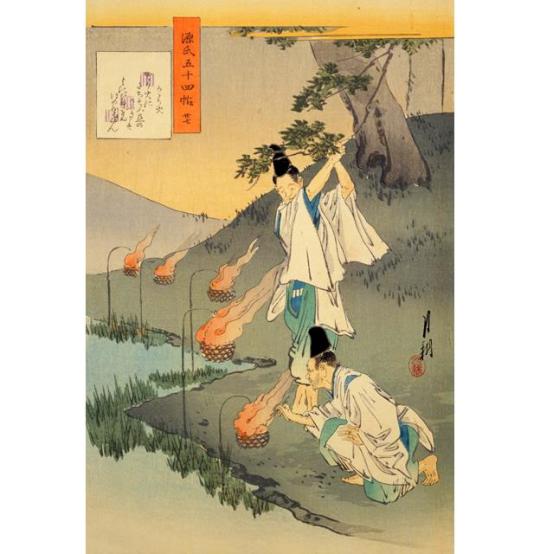
Here, it is unclear whether Tanaka believed that the smoke from the fire in the kagari-bi would be sufficient to drive the mosquitoes away, or whether he is using the word eji-kago to refer to a similar sort of arrangement -- albeit one in which pine needles or mugwort, or some other special material, would be burned in similar manner to produce the desired fumigatory or mosquito-repelling effect.
The reference that he makes to bronze cranes and ducks installed in the garden is either addressing the matter of the supports from which the containers of smoldering incense (usually crushed jin-kō [沈香] or kyara [伽羅], or blends based on these) were suspended (the bowls were taken in when incense was not being burned, leaving the bronze statues standing in the garden as decorative objects in their own right), or to bronze censors cast in these shapes (such as the one shown below) that were set out in the garden to perfume the air.
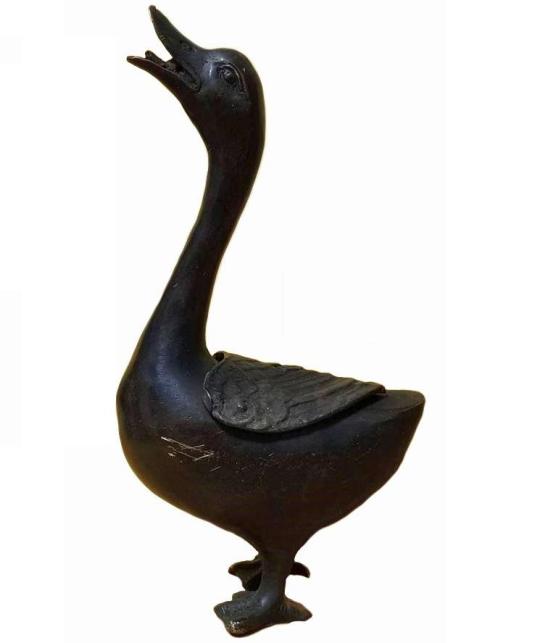
It might be added that most of the oldest tsuri-bune [釣り船] imported from Mogul India and China were originally made as hanging incense burners.
‡This plant is called yomogi [よもぎ = 蓬) in Japanese, and ssuk [쑥] in Korea. In addition to its mosquito-repellent qualities (in Korea, the plant was traditionally cultivated along the edge of the veranda, since even when living the essential oils volatilize into the air, deterring mosquitos; and in the autumn the stalks were cut down to the ground, and then suspended upside-down under the eves to dry for use as a kayari (fumigant) the next year). Mugwort is also used in both country’s cuisine; in Korea, it is also used in certain varieties of traditional sweets (though strongly-flavored sweets of this kind fell out of favor in Japan early in the 20th century -- when the preference shifted to tastes that would best appeal to young women). Mugwort is also used in the traditional medicine of both countries (and the mugwort-flavored sweets were just one example).
**While originally produced as straight incense sticks, the coil version of katori-senkō seems to have appeared during the Edo period as well -- allowing for a longer-burning piece of incense that was not spatially limited as a linear stick would have been.
††The fact that the roji is watered so frequently means that mosquitoes are an inevitable menace from late spring to deep autumn, where they usually attack the participants at the exposed strip of skin between the edge of the tabi and the hem of one’s kimono -- a sensitive area where their bite is horribly annoying (especially in Japan, where the custom is to avoid touching the feet and ankles as much as possible, so the brief relief of scratching is completely out of the question).
⁵Kyū mite, sasuga ni fūryū-no-koto kana to kanshin-shi [休見テ、サスガニ風流ノコトかナト感心シ].
Kyū mite [休見て] means (and) when Rikyū saw this...
Sasuga ni fūryū* no koto kana [流石に風流のことかな] means “indeed, isn’t that most tasteful!” These words were supposed to have been murmured by Rikyū when he noticed the faint tendrils of smoke trailing through the plantings†.
To kanshin-shi [と感心し] means as he was deeply moved (by the sight).
___________
*The expression fūryū [風流], especially as it is being used here, did not enter the lexicon of the chajin until the Edo period (indeed, fūryū was, culturally, a very important and popular way of describing moving, tasteful, and “artistic” experiences from the second half of the seventeenth century onward). This helps us understand that this text, while possibly based on a real incident -- the first time that a kayari-bi was used during a tea gathering to keep the roji and koshi-kake free of insects during night gatherings in the summer -- could not have been written until the late seventeenth century.
†Perhaps it initially reminded him of the smoke of the burning pine needles that trailed through the pine trees during the fusube-chanoyu [ 燻べ 茶の湯] that Rikyū had created for Hideyoshi as a way to enjoy chanoyu even in the pine barrens at Daizen-ji and Hakozaki, during the Kyūshū campaign of 1586~7.
See the post entitled Nampō Roku, Book 7 (66): Fusube-chanoyu [フスベ茶湯] – a Tea Gathering Held Out-of-doors for further details. The URL is:
https://chanoyu-to-wa.tumblr.com/post/726511147567775744/namp%C5%8D-roku-book-7-66-fusube-chanoyu-%E3%83%95%E3%82%B9%E3%83%99%E8%8C%B6%E6%B9%AF
⁶Sono ato, roji・koshikake no atari, ko-kage no shikaru-beki-tokoro ni, kayari wo takare-shi-koto ari [其後、露地・腰カケノアタリ、木陰ノシカルベキ所ニ、カヤリヲタカレシコトアリ].
Sono ato [その後] means after that, later on, afterward.
The implication is that this gathering, hosted by Hino Terusuke, was the first occasion on which a kayari-bi had been used, secreted under the trees to clear the area of noxious insects during the chakai. The realization of how useful this would be is why Rikyū is made to be so impressed and moved -- because he had never though of doing something like that himself*.
Roji・koshikake no atari [露地腰掛の當り] means in an out-of-the-way place in the roji and koshi-kake; on the edge of the roji and koshi-kake.
Ko-kage no shikaru-beki-tokoro ni [木陰の然るべき所に]: ko-kage [木陰], as above, means in the shade of the trees (in other words, in an inobvious place under the trees that were planted to obscure the fences that enclose the roji from view); shikaru-beki-tokoro ni [然るべき所に] means in a suitable place, in the right place.
Kayari wo takare-shi-koto ari [蚊遣を薫かれしことあり] means the fumigant† should be set to smoldering‡ (in the shade under the trees).
__________
*It appears that the burning of kayari originated with, and was largely restricted to, the Imperial Court -- with kayari-bi set up in obscure corners of the various ceremonial and audience halls, to eliminate mosquitoes that would have disrupted the proceedings (since mosquitoes remain active even during the daytime in such large, and dark, spaces, and court ceremonials and audiences could carry on for hours without a break).
†Kayari [蚊遣] -- without the -bi [火] -- means a fumigant or mosquito repellent; however, this short form was also used informally as a way to refer to the kayari-bi, as a self-contained unit, so either interpretation would be correct.
‡This particular verb, takareru [薫かれる], is used specifically to mean to “burn” something like incense -- not with an active flame, but so that it smolders slowly.
==============================================
◎ If these translations are valuable to you, please consider donating to support this work. Donations from the readers are the only source of income for the translator. Please use the following link:
https://PayPal.Me/chanoyutowa
2 notes
·
View notes
Text
日本の歴史366 Day 43
2月12日 Summary:
After seizing power in the Battle of Sekigahara in 1600, Tokugawa Ieyasu was finally able to become a shogun in 1603. Ieyasu is the first shogun of the Tokugawa Shogunate. However, he was already in his 60s, so he willingly abdicated his position to his third son, Hidetada, in 1605.
Vocab beneath the break:
江戸幕府 えどばくふ Edo shogunate (1603-1867) (also known as Tokugawa shogunate)
開かれる ひらかれる to be open
将軍 しょうぐん shogun
かかる to take (a resource, e.g. time or money)
徳川家康 とくがわいえやす Tokugawa Ieyasu (founder and first shogun of the Tokugawa Shogunate); considered to be one of the three "Great Unifiers" of Japan [x]
関ヶ原の戦い せきがはらのたたかい Battle of Sekigahara (1600)
勝つ かつ to win
征夷大将軍 せいいたいしょうぐん shogun; great, unifying leader (a commander of force)
指名 しめい naming; nominating; designating
天下 てんか supremacy over a nation; government of a country; the ruling power; shogun (Edo period)
父上 ちちうえ father (sonkeigo)
家来 けらい retainer; retinue; servant
大久保忠隣 おおくぼただちか Ookubo Tadachika
進め すすめ recommendation; advice; suggestion; encouragement
三男 さんなん third son
徳川秀忠 とくがわひでただ Tokugawa Hidetada (second shogun of the Tokugawa clan; Tokugawa Ieyasu's third son and successor)
ついに finally; at last
念願 ねんがん one's heart's desire; one's dearest wish
日々 ひび days (e.g. of one's youth); every day; day after day; day by day; from day to day
一族 いちぞく family; relatives; dependents; household
代々 だいだい for generations; from generation to generation; generation after generation; through the ages
受けつぐ うけつぐ to inherit; to succeed; to take over
#shay's taking notes#japanese history 366#japanese history#japanese culture#japanese figures#japanese#learn japanese#study japanese#jpnstudynet#history buff#history tumblr#langblr#studyblr#japanese langblr#studyspo#tokugawa shogunate#tokugawa clan#tokugawa family#tokugawa ieyasu#oda nobunaga#tokugawa hidetada#ieyasu tokugawa#hidetada tokugawa#battle of sekigahara#shogun#shogunate#japanese wars#japanese battles
7 notes
·
View notes
Text

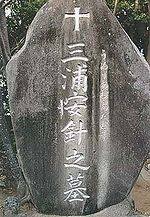
Foreign Samurai, Miura Anjin, (William Adams) died on This Day, May 16, 1620.
Having lived in Japan for 20 years, and serving Tokugawa Ieyasu as an advisor and interpreter, William Adams died while on a business related visit to Hirado, north of Nagasaki on May 16, 1620, aged 55. He was buried in Nagasaki, where his grave marker remains. Within ten years, only two of Adams's shipmates from 1600 remained in Japan. Melchior van Santvoort (D. 1641) and Vincent Romeyn lived in Nagasaki, until being expelled along with all foreigners from Japan in 1639, by orders of the Shogun.
William Adams was the Pilot-Major of the Liefde, a Dutch ship of 300 tons with a crew of 110 that arrived in Japan in April of 1600. The Liefde was one of five ships that had set out two years earlier in the hopes of reaching Japan to commence trading. Only Adams' ship reached the shores of Japan. Adams, who was to spend the rest of his life in Japan, was treated as personal advisor to Tokugawa Ieyasu in a number of matters.
Ieyasu took a liking to Adams due to his intelligence and understanding of mathmatics and nautical engineering. Although Adams had a wife and children in England, Ieyasu forbade him to leave Japan. Instead, Adams became an advisor on western issues and later became the shogun’s official interpreter. In return for his loyalty, Ieyasu granted many privileges.
Adams was provided with the two swords of the samurai, an exalted position as a direct retainer, or Hatamoto (bannerman) and an estate valued at 250 koku (One koku was defined as the amount of rice sufficient to feed one person for one year) with a staff of over 80. In doing so, the Shogun Ieyasu announced that the Englishman, William Adams, was dead, and Miura Anjin, (三浦按針) a samurai, was born.
Following his death, Adams' son, Joseph, kept the title of Miura Anjin, as confirmed by the second shogun, Hidetada, and continued to engage in trade until Japan banned foreign trading in 1635, after which he and his sister disappeared from historical records.
8 notes
·
View notes
Text
I really itchy to write a next generation of KHR just to shove a bunch of Tokugawa shogun name in this fandom.
Tsuna gonna has two boy Yoshinobu and Hidetada and they gonna goes by 40 (Yo-no) and 13 (Hi-da). I know if our boy become the Decimo/Neo Primo he gonna be in Italy but the tradition of naming after shogun is so nice why everyone prefer he had Ciel, Cielo and whole bunch of other name as his son?
Edit: And the whole "Tsuna has a siblings" too I mean come on why 70% of them has to be Ieyasu did Giotto already claim that?
#if he has a girl maybe i go with Japanese princess name#like Hanako - Princess Hitachi or Kaoruko-naishinno#a bunch of material from history#that can use as foreshadow#such nice tradition why no one use it#khr
2 notes
·
View notes
Text

Title: But it is a harem
Alternatively titled 'Yes I'm still dunking on Kasuga'.
Man, it's been a hot (no pun intended) minute since I last drew something (I blame the heat practically sucking my motivation to draw 💀), so that's why Master!me looks somewhat awkward (big head, smaller body).
This was my first time drawing Kasuga/Parvati so I hope she doesn't look too bad, but man I hate that there's so much pink in her design, my pink pen's on verge of being dead, so her kimono looks a bit more roughed up than I wanted it to be.
And speaking of Kasuga, fun fact, despite how the event made her to be the de-facto manager of the Ooku, she actually co-managed it with Oeyo (who's also called Go, Ogo, and Satoko), who's not only the wife of the second Shogun (Tokugawa Hidetada) and the mother of the third Shogun (Tokugawa Iemitsu), but she's also Chacha/Yodo-dono's sister. Would've been nice if she was mentioned, guys! (Yes, this is a hill that I'm going to die on)
And before you say anything, yes, I know that the Ooku isn't The Sex Place (despite what Kama's claiming), it's also where the female servants and the Shogun's children (both from the wife and the concubines) also reside in it, but of course, literally no one else brings those up, so *shrugs*.
#Fate/Grand Order#Kasuga-no-Tsubone (FGO)#Mastersona#my art#here a drawing! (also gives a history lesson)#my sis the staff member
5 notes
·
View notes
Text
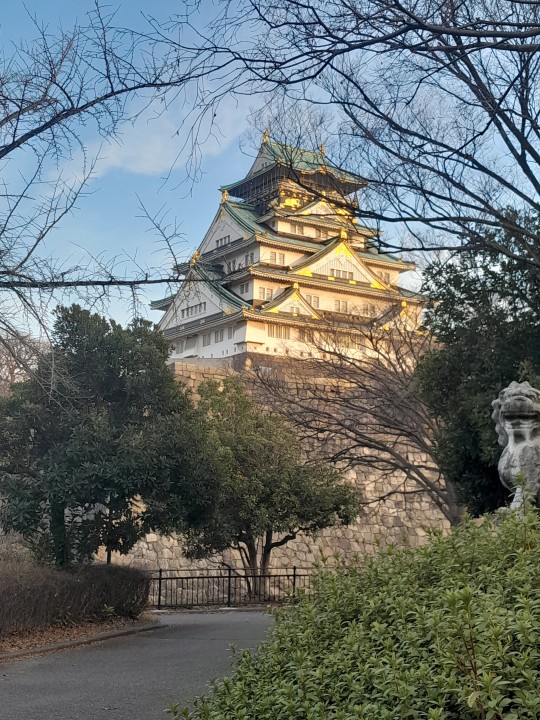
According to Daiki's version of history, Hideyoshi was a geniius who later became basically a brutal dictator.
Anyway, for context -- "A few years after Hideyoshi's death, Tokugawa troops attacked and destroyed the castle and terminated the Toyotomi lineage in 1615. Osaka Castle was rebuilt by Tokugawa Hidetada in the 1620s, but its main castle tower was struck by lightening in 1665 and burnt down....(in) 1931 that the present ferro-concrete reconstruction of the castle tower was built."
"The castle tower is surrounded by secondary citadels, gates, turrets, ..stone walls and moats. The Nishinomaru Garden...is a lawn garden with 600 cherry trees, a tea house..."
0 notes
Text
(Sunpu Castle - 1605)
In the shadowed confines of Sunpu Castle, a place where the pulse of ancient Japan could still be felt in its silent halls and age-old traditions, a pivotal and clandestine ceremony was taking place. This secluded chamber, adorned with intricate fusuma screens depicting scenes of nature and mythology, was a fitting backdrop for the convergence of two worlds.
Tokugawa Ieyasu, who had abdicated the official title of Shogun in 1605 in favor of his son Hidetada, stood with a calm yet imposing presence. His decision to step down was strategic, allowing him to maintain the true reins of power while freeing himself from the ceremonial duties that tied the hands of a Shogun. It was a move that also aimed to ensure a smooth succession for his son and make it more challenging for enemies to target the true center of authority.
As the sun set, casting a golden hue through the wooden lattice, members of the Assassins' Brotherhood emerged from the shadows. These silent guardians, dressed in attire that blended the traditional with the mystical, were there to forge a new alliance. The eldest among them, a revered figure within their ranks, approached Ieyasu with a solemnity that matched the gravity of the occasion.
In his hands, he held the legendary hidden blade of the Assassins, a tool of silent retribution and a symbol of their creed. Ieyasu, understanding the symbolic weight of this moment, extended his arm, allowing the elder to affix the hidden blade. The cold metal against his skin was a tangible reminder of the dual life he was about to embrace.
"Wareware no michi wa, kore kara mo tsuzuku." (Our path continues from here), Ieyasu spoke in measured tones, his voice resonating with the authority of his position and the solemnity of the occasion. "Kono yaiba to tomo ni, ware wa yami o kirisaite, heiwa o mamoru." (With this blade, I will cut through the darkness to protect our peace.)
The Brotherhood members bowed in silent respect, acknowledging the depth of Ieyasu's commitment. This ceremony was not merely about bestowing a title or a weapon; it was about entrusting the balance of power to one who had shown the acumen to wield it wisely.
"Ware wa kono creed no michi o ayumu. Arasoi no naka ni chitsujo o, kusatta mono ni wa shinri o, bōgyo suru mono ni wa jiyū o." (I will walk the path of our creed. In conflict, I bring order; to the corrupt, truth; to the oppressed, freedom), Ieyasu declared, his gaze unwavering, the hidden blade a silent testament to his words.
The room held its breath, the very air charged with the gravity of his oath. Then, as if on cue, the Brotherhood disappeared as silently as they had arrived, melting back into the night from which they had emerged. Only the shogun remained, contemplating the dual life he was to lead—one in the light of governance and one in the shadow of vigilant justice.
0 notes
Text
1615-Siege of Osaka

The siege of Osaka(大坂の役, Ōsaka no Eki, or, more commonly, 大坂の陣 Ōsaka no Jin) was a series of battles undertaken by the Japanese Tokugawa shogunate against the Toyotomi clan, and ending in that clan's destruction. Divided into two stages (winter campaign and summer campaign), and lasting from 1614 to 1615, the siege put an end to the last major armed opposition to the shogunate's establishment.


*(left) Toyotomi Hideyori (豊臣 秀頼, August 28, 1593 - June 4, 1615) was the son and designated successor of Toyotomi Hideyoshi, the general who first united all of Japan. His mother, Yodo-dono, was the niece of Oda Nobunaga.
*(right) Yodo-dono (淀殿) or Yodogimi (淀君) (1569 – June 4, 1615) was a prominently placed figure in the late-Sengoku period. She was a concubine and second wife of Toyotomi Hideyoshi, and Hideyori's mother, who was then the most powerful man in Japan.

* The fall of Osaka Castle: On June 5, 1615, Tokugawa attacked Osaka Castle, an attack known as "the summer Siege of Osaka". After another series of shogunate victories on the outskirts of Osaka, the summer campaign came to a head at the battle of Tennōji. The smaller force led directly by Hideyori sallied forth from Osaka Castle too late, and was chased right back into the castle by the advancing enemies; there was no time to set up a proper defense of the castle, and it was soon ablaze and pummeled by artillery fire.


Hideyori and Yodo-dono took refuge in a fireproof warehouse, as much of the castle was in flames. Ōno Harunaga sent Hideyori's wife, Senhime, with his father Hidetada to be forgiven, and to plead for the life of her husband and mother-in-law. Without waiting for answers, Toyotomi Hideyori and Yodo-dono committed seppuku in the flames of Osaka castle, ending the Toyotomi legacy.
The final major uprising against Tokugawa rule was put to an end, leaving the shogunate unchallenged for approximately 250 years.
#Jun.4.1615#date of death#Toyotomi Hideyori#Yodogimi#The fall of Osaka Castle#end of Toyotomi clan#history today
0 notes
Photo
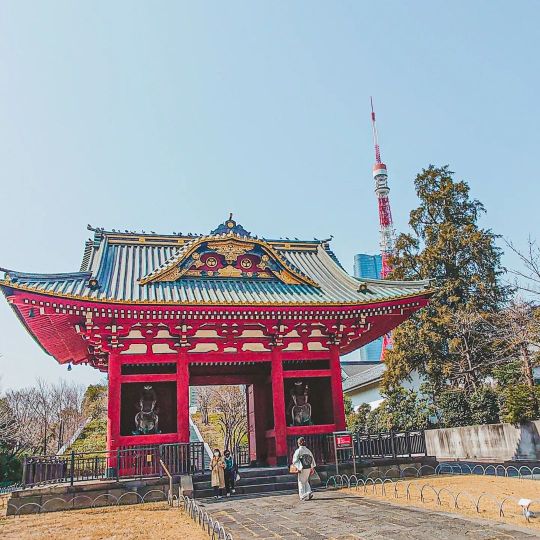
Yesterday we took a walk from Azabujuban shopping street to Shiba park and Zojoji. The very first day not wearing a coat! The virtual walk is on my YouTube channel (link in stories). I started these walks because I want to show my family back home the places I see - and I love Tokyo too much! The building was the main gate of the mausoleum of Hidetada Tokugawa, the second shogun of the Edo Shogunate, and is an important cultural property. The mausoleum was built on the south side of the precincts of Zojo-ji Temple in 1788, the year Hidetada died. It was the largest of the Tokugawa family mausoleums, but most of it was destroyed in the WWII raids. 🚇 Closer stations: Shibakoen (Mita line) and Akabanebashi (Oedo line). #shibakoen #shibapark #tokyotower #tokyotowerview #japaneseculture #japantourism #japanesecultureexperience #japanesehistory #japanesehistoryandculture #japanesehistoricalplace #zojoji #zojojitemple #東京タワー #東京タワー景色 #芝公園 #増上寺 #増上寺と東京タワー #virtualtravel #virtualwalk #virtualwalkthrough (presso Shiba Koen) https://www.instagram.com/p/CpsO4BiPsvy/?igshid=NGJjMDIxMWI=
#shibakoen#shibapark#tokyotower#tokyotowerview#japaneseculture#japantourism#japanesecultureexperience#japanesehistory#japanesehistoryandculture#japanesehistoricalplace#zojoji#zojojitemple#東京タワー#東京タワー景色#芝公園#増上寺#増上寺と東京タワー#virtualtravel#virtualwalk#virtualwalkthrough
0 notes